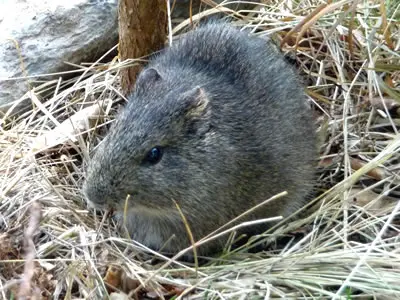General Information
Guinea pigs are among the most popular household pets available, and it's not hard to see why. Their cute looks, relaxed temperament, and ease of caring make them perfect for all animal lovers, including the young and those without enough time to keep a demanding pet.
If you are considering buying a guinea pig, or simply want to learn more about your pets, then here's our list of essential guinea pig information for kids and adults alike:
Origins
Guinea pigs come from South America, near the Andes mountain range. They were originally wild animals, but were domesticated many centuries ago by the local people. They soon became hugely important in South American culture, being kept as pets, used in religious ceremonies and medicine, and even eaten as food.
Wild guinea pigs live in mountains and grasslands. Image by Sibi.
They were first introduced into Europe by travellers and explorers in the 16th century, and became seen as very exotic pets to own - even Queen Elizabeth I had one!
Family and Name
Guinea pigs are rodents, which means they are part of the same family as hamsters, mice, and gerbils. They are also commonly known as 'cavies', which comes from their Latin name, 'Cavia porcellus'.
Nobody knows for sure how they came to be known as 'guinea pigs' because they are neither pigs nor from Guinea. However, it has been suggested that the 'guinea' part may just be a reference to the fact that they came from an exotic, far-away country, and the 'pig' part is because they have short, stubby bodies and large heads, making them look almost like a small pig.
Characteristics
Cavies are mostly quiet and docile, which means that they are very easy to handle - they generally don't try to jump off your lap like other pets do! They have poor eyesight but excellent senses of smell and hearing, and will respond excitedly, jumping and leaping around if they hear you walk into the room, or if they smell a treat being prepared for them.
Although guinea pigs have poor sight, their senses of smell and hearing are excellent. Image by digital_image_fan.
Guinea pigs communicate by 'talking' to each other, and you will often hear them chattering away making a variety of sounds and noises to one another. This is very cute to watch, and if you take the time to learn what the various sqeaks, squeels and purrs mean, you will be able to understand your pets much better.
Size and Weight
Guinea pigs are much larger than other rodents, and can grow up to 30 cm (12 inches) in size, and as much as 1,200 grams (2.5 lb) in weight. Because of their size, they are generally easier to hold and handle than smaller pets, although young children may find them a bit heavy to lift on their own.
Because of their size, guinea pigs are easy to hold. Image by cjnzja.
Life Span
As well as being much bigger than other rodents, they also tend to have a much longer life span - generally between 4 and 6 years, but sometimes as much as 8. Although this makes guinea pigs a long-term commitment, it also means that you will form a very strong bond with your animals.
Habitat
In the wild, guinea pigs live on plains, sheltering in grass and bushes, and sometimes using other animals' burrows for protection. They are very sociable animals and live in small herds, typically consisting of one male, several females, and their offspring.
Guinea pigs are sociable animals and like to live in groups. Image by photon.
When kept as pets, they still love to live in groups of two or more, although you should be careful when putting two or more boars (males) together as they can fight. You should give your guinea pigs a large cage so that they have plenty of room to run around, and so they can spend some time alone, away from their cagemates.
Diet
Guinea pigs are herbivores and live off hay, grass, vegetables, and fruit, supplemented with a good quality dry food. These provide them with a healthy balance of nutrients and vitamins to keep their bodies in good working order and to fend off illness. Unlike other rodents, they cannot produce vitamin C in their bodies, so they need to get plenty in their diet.
Be sure to feed your guinea pig a healthy, varied diet. Image by David Locke.
Their teeth are constantly growing, and are kept short by biting and grinding abbrasive materials such as hay, grass, and wooden nibblers.
Hopefully the information above will give you a good basic understanding of your guinea pigs, their behaviour, and how to treat them. For more detailed information, be sure to explore the rest of this site!

